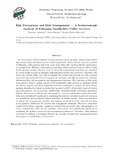| dc.description.abstract | In recent years, coffee producers’ risk has become one of the major issues in the current
discussions within the International Coffee Organisation (ICO) and its member countries.
In Ethiopia, coffee growers deal with many risks while often lacking effective mechanisms
to manage them. However, information concerning “which sources of risk to coffee income
do the growers consider relevant” and “in what risk management tools they are interested
in” is too scanty to gain an adequate understanding of their risk behaviour. Therefore, the
main aims of this study were (1) to identify the extent and diversity of coffee growers’
perceived risks and preferred risk management strategies, and (2) investigate the variables
influencing their risk perceptions and management responses. The data used in this study
were gathered from a random sample of 195 smallholder coffee growers in southwest Ethiopia.
Factor analysis and linear regression have been employed to analyse the data. Factor
analysis identifies five latent variables that account for 62% of the total observed variations
in the growers’ risk perceptions. Additionally, estimated results from linear regressions
indicate that resource endowments, demographics, access to information and location attributes
were statistically significant in explaining the observed variation in growers’ scores on
the underlying risk perceptions (latent variables). In similar manner, factor analysis finds
six latent risk management variables and explains about 64% of the observed variation
in the growers’ preferences for various risk management strategies. Moreover, estimation
results of the linear regression equations revealed that perceived risks, demographics, resource
endowments, coffee income volatility, and location were statistically significant in
explaining the growers’ scores on risk management preferences. Therefore, these information
must be utilised to formulate effective and broadly accepted risk management policy
and support to smallholder coffee growers. | en |

